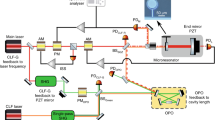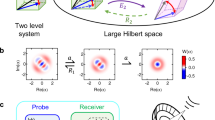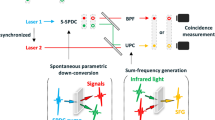Abstract
The black body remains the most prominent source of light for absolute radiometry1. Its main alternative, synchrotron radiation, requires costly and large facilities2. Quantum optics offers a new radiometric source: parametric down-conversion (PDC), a nonlinear optical process, in which pairwise photon correlations enable absolute calibration of photodetectors3,4,5,6. Since the emission rate crucially depends on the brightness of the electromagnetic field, quantum-mechanical fluctuations of the vacuum7 can be seen as a seed of spontaneous PDC, and their amplitude is a natural radiometric standard. Thus, they allow for the calibration of the spectral radiance of light sources8,9,10,11 by measuring the ratio between seeded and unseeded PDC. Here, we directly use the frequency spectrum of the electromagnetic vacuum to trigger spontaneous PDC and employ the generated light to infer the spectral response of a spectrometer over a broad spectral range. Then, we deduce the absolute quantum efficiency from the spectral shape of PDC in the high-gain regime, without relying on a seed or reference detector. Our results compare well with the ones obtained with a reference lamp, demonstrating a promising primary radiation standard.
This is a preview of subscription content, access via your institution
Access options
Access Nature and 54 other Nature Portfolio journals
Get Nature+, our best-value online-access subscription
$29.99 / 30 days
cancel any time
Subscribe to this journal
Receive 12 print issues and online access
$209.00 per year
only $17.42 per issue
Buy this article
- Purchase on Springer Link
- Instant access to full article PDF
Prices may be subject to local taxes which are calculated during checkout




Similar content being viewed by others
Data availability
The data that support the plots within this paper and other findings of this study are available from the corresponding author on reasonable request.
Change history
13 June 2019
An amendment to this paper has been published and can be accessed via a link at the top of the paper.
References
Hollandt, J. et al. in Optical Radiometry: Volume 41 (Experimental Methods in the Physical Sciences) (eds Parr, A. C. et al.) Ch. 5 (Elsevier, Amsterdam, 2005).
Lemke, D. & Labs, D. The Synchrotron Radiation of the 6-GeV DESY Machine as a Fundamental Radiometric Standard. Appl. Opt. 6, 1043–1048 (1967).
Klyshko, D. N. Use of two-photon light for absolute calibration of photoelectric detectors. Sov. J. Quantum Electron. 10, 1112–1117 (1980).
Malygin, A. A., Penin, A. N. & Sergienko, A. V. Absolute calibration of the sensitivity of photodetectors using a biphotonic field. JETP Lett. 33, 477–480 (1981).
Polyakov, S. V. & Migdall, A. L. High accuracy verification of a correlated-photon-based method for determining photon-counting detection efficiency. Opt. Express 15, 1390–1407 (2007).
Rarity, J. G., Ridley, K. D. & Tapster, P. R. Absolute measurement of detector quantum efficiency using parametric downconversion. Appl. Opt. 26, 4616–4619 (1987).
Klyshko, D. N. Photons and Nonlinear Optics (Gordon and Breach, Boca Raton, 1989).
Klyshko, D. N. Utilization of vacuum fluctuations as an optical brightness standard. Sov. J. Quantum Electron. 7, 591–595 (1977).
Kitaeva, G. Kh., Penin, A. N., Fadeev, V. V. & Yanait, Yu. A. Measurement of brightness of light fluxes using vacuum fluctuations as a reference. Sov. Phys. Dokl. 24, 564–566 (1979).
Migdall, A., Datla, R., Sergienko, A., Orszak, J. S. & Shih, Y. H. Measuring absolute infrared spectral radiance with correlated visible photons: technique verification and measurement uncertainty. Appl. Opt. 37, 3455–3463 (1998).
Kornienko, V. V., Kitaeva, G. Kh., Sedlmeir, F., Leuchs, G. & Schwefel, H. G. Towards terahertz detection and calibration through spontaneous parametric down-conversion in the terahertz idler-frequency range generated by a 795 nm diode laser system. APL Photon. 3, 051704 (2018).
Lemieux, S. et al. Engineering the frequency spectrum of bright squeezed vacuum via group velocity dispersion in an SU(1, 1) interferometer. Phys. Rev. Lett. 117, 183601 (2016).
Milonni, P. Field quantization and radiative processes in dispersive dielectric media. J. Mod. Opt. 42, 1991–2004 (1995).
Spasibko, K. Yu, Iskhakov, T., Sh. & Chekhova, M. V. Spectral properties of high-gain parametric down-conversion. Opt. Express 20, 7507–7515 (2012).
Hsu, F.-K. & Lai, C.-W. Absolute instrument spectral response measurements using angle-resolved parametric fluorescence. Opt. Express 21, 18538–18552 (2013).
Dayan, B. Theory of two-photon interactions with broadband down-converted light and entangled photons. Phys. Rev. A 76, 043813 (2007).
Agafonov, I. N., Chekhova, M. V. & Leuchs, G. Two-color bright squeezed vacuum. Phys. Rev. A 82, 011801 (2010).
Allevi, A. et al. Coherence properties of high-gain twin beams. Phys. Rev. A 90, 063812 (2014).
Brida, G., Meda, A., Genovese, M., Predazzi, E. & Ruo-Berchera, I. Systematic study of the PDC speckle structure for quantum imaging applications. J. Mod. Opt. 56, 201–208 (2009).
Pérez, A. M. et al. Bright squeezed-vacuum source with 1.1 spatial mode. Opt. Lett. 39, 2403–2406 (2014).
Yoon, H. W., Gibson, C. E. & Barnes, P. Y. Realization of the National Institute of Standards and Technology detector-based spectral irradiance scale. Appl. Opt. 41, 5879–5890 (2002).
Datla, R. U. & Parr, A. C. in Optical Radiometry: Volume 41 (Experimental Methods in the Physical Sciences) (eds Parr, A. C. et al.) Ch. 1 (Elsevier, Amsterdam, 2005).
Eimerl, D., Davis, L., Velsko, S., Graham, E. K. & Zalkin, A. Optical, mechanical, and thermal properties of barium borate. J. Appl. Phys. 62, 1968–1983 (1987).
Boyd, R. W. Nonlinear Optics (Academic, Burlington, 2003).
Acknowledgements
We thank O. Reshef for valuable discussions. This research was performed as part of a collaboration within the Max Planck-University of Ottawa Centre for Extreme and Quantum Photonics, whose support we gratefully acknowledge. This work was supported by the Canada First Research Excellence Fund award on Transformative Quantum Technologies and by the Natural Sciences and Engineering Council of Canada (NSERC). R.F. acknowledges the financial support of the Banting postdoctoral fellowship of the NSERC and S.L. the financial support from Le Fonds de Recherche du Québec Nature et Technologies.
Author information
Authors and Affiliations
Contributions
M.V.C. conceived the idea for relative calibration. S.L., E.G. and R.F. extended that idea to the absolute calibration scheme. S.L. and R.F designed the experiment. S.L. conducted the experiment and performed the data analysis. S.L., E.G. and R.F. wrote the manuscript. M.V.C. and R.W.B. supervised the project. All authors contributed to scientific discussions.
Corresponding author
Ethics declarations
Competing interests
S.L., M.V.C. and R.W.B., along with coinventors M. Manceau and G. Leuchs, the University of Ottawa and the Max Planck Institute for the Science of Light, have an international patent application (PCT/IB2017/056450) currently pending, about the relative calibration using PDC. E.G. and R.F. declare that they have no competing interests.
Additional information
Publisher’s note: Springer Nature remains neutral with regard to jurisdictional claims in published maps and institutional affiliations.
Supplementary information
Supplementary Information
Supplementary Material.
Rights and permissions
About this article
Cite this article
Lemieux, S., Giese, E., Fickler, R. et al. A primary radiation standard based on quantum nonlinear optics. Nat. Phys. 15, 529–532 (2019). https://doi.org/10.1038/s41567-019-0447-2
Received:
Accepted:
Published:
Issue Date:
DOI: https://doi.org/10.1038/s41567-019-0447-2
This article is cited by
-
An electron turnstile for frequency-to-power conversion
Nature Nanotechnology (2022)



